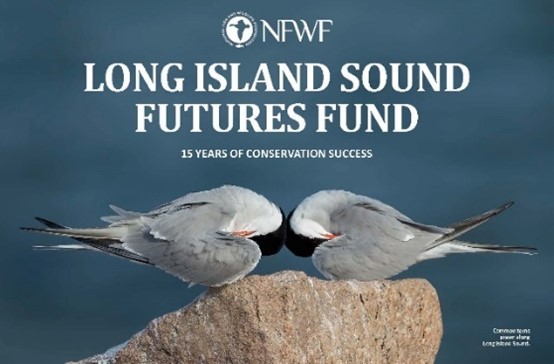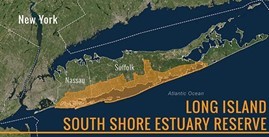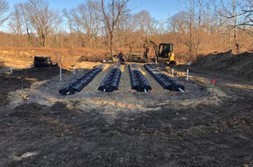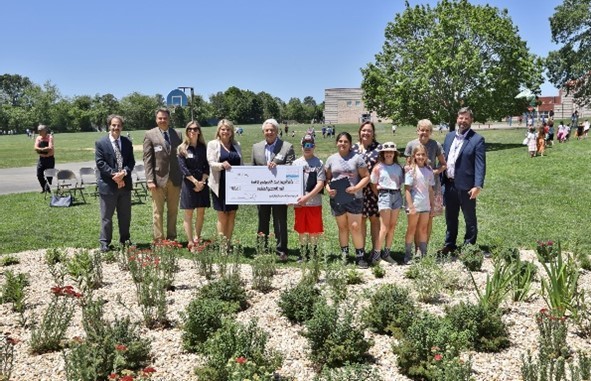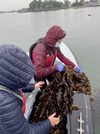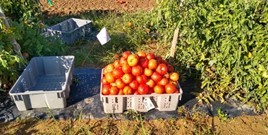Long Island Nitrogen Action Plan (LINAP) – Monthly Newsletter |
Nassau CountyThis year Nassau County saw the launch of the Septic Environmental Program to Improve Cleanliness (SEPTIC) program, which provides funding to eligible residents and small businesses to replace a cesspool or septic system with Innovative Alternative Onsite Wastewater Treatment Systems (I/A OWTS), and the program is being well received. The groundbreaking of the Bay Park Conveyance Project was another accomplishment for Nassau County and will convey treated water from the South Shore Water Reclamation Facility (SSWRF), which currently discharges into Reynolds Channel, to the ocean outfall pipe at the Cedar Creek Water Pollution Control Plant. Additionally, the County has made progress on advancing the Long Beach Water Pollution Control Plant (WPCP) Consolidation Project which will convert the plant to a pump station and reroute Long Beach sewage to the newly upgraded SSWRF, where the sewage will be treated to a higher standard. This project along with the Bay Park Conveyance Project will remove a total of approximately 55 million gallons per day of treated wastewater effluent from the Western Bays! Updates have also begun on the Nitrogen Loading Modeling for Nassau County Subwatersheds report that the County released last year. The revisions will turn the original study into a 9 Element Watershed Plan and focus on identifying the causes and sources of non-point source pollution, engaging key stakeholders in the planning process and developing strategies that will address water quality concerns. Projects identified in 9 Element Watershed Plans are eligible for federal and state funding.
Construction on Bay Park Conveyance Project. Photo Credit: Nassau County Suffolk County2021 was a historic year for Suffolk County as many nitrogen reducing initiatives saw significant advancements including the expansion of sewer systems through the Suffolk County Coastal Resiliency Initiative, and an exponential increase in the installations of I/A OWTS through the County’s Septic Improvement Program. The first of multiple sewer projects across the County broke ground in October and will connect 2,184 homes in the Carlls River Watershed in the Town of Babylon to the Suffolk County Sewer District and 1,884 properties in the Forge River Watershed in Brookhaven to a new treatment plant being built in Mastic. This represents the largest expansion of sewer infrastructure in Suffolk County in nearly 50 years! To date the County has awarded over 3,000 grants to homeowners to replace septics and cesspools with I/A OWTS. In furtherance of these extraordinary efforts to replace cesspools and septics, an amendment to the County’s sanitary code, that was unanimously passed, went into effect on July 1 requiring I/A OWTS on all new construction and major reconstruction. The law also allows greater flexibility for the use of small sewer plants in downtown business districts.
Sewer expansion groundbreaking in theTown of Babylon. Photo Credit: Suffolk County Peconic Estuary PartnershipNitrogen management is a critical part of the Peconic Estuary Partnership’s (PEP) strategy to protect and restore water quality in the Peconic Estuary. PEP made significant progress on many nitrogen focused projects such as the Solute Transport Model, which will estimate time-varying nitrogen loading rates to the Peconic Estuary, and the Nitrogen Assessment Project to assess the cost, per pound, of nitrogen removal for nitrogen reduction best management practices currently being employed throughout the country. The Homeowner Rewards Program, which provides Peconic watershed residents the chance to apply and be reimbursed for installing rain gardens, native plant gardens and rain barrels on their properties, continues to operate successfully. New projects taken on this year included work on the Stormwater Wetlands Project at Meetinghouse Creek and the Living Shoreline Nutrient Bioextraction Pilot Project. This year the PEP also finalized a Water Quality Monitoring Strategy. The Strategy includes a summary of existing water quality monitoring programs underway in the Peconic Estuary and an assessment of whether data collected by those programs can adequately track and detect changes in water quality needed to assess progress towards the goals identified in the 2020 Comprehensive Conservation and Management Plan (CCMP). Read more information about PEP in LINAP’s July newsletter.
Homeowners Rewards Program projects. Photo Credit: Peconic Estuary Partnership Long Island Sound Study (LISS)This past spring, the Long Island Sound Study Management Committee finalized a $31.1 million budget and work plan for the federal fiscal year 2021 – the largest budget in LISS history! The complete 2021 work plan and budget, including a list and descriptions of all projects and initiatives can be found here. Included in this year’s budget was funding to support the Solute Transport Model expansion for the entirety of Long Island. Once the model is complete for the entire Island, LISS will be able to use the model to predict how nitrogen reduction strategies will impact the Sound. Additionally, others will be able to use the model by developing and running land use scenarios for parts of Long Island. The Long Island Sound Study Futures Fund, with management support from the National Fish and Wildlife Foundation (NFWF), has provided support to local organizations, municipalities, and universities to develop environmental projects that help to fulfill the objectives of the Long Island Sound’s Comprehensive Conservation and Management Plan (CCMP). This year the NFWF published a report showing how the program has made a difference in improving the health of the Sound. Environmental Justice (EJ) has been a key principle in the CCMP and in October the Environmental Justice Work Group (EJWG) was formed. The EJWG will focus on identifying and meeting local environmental justice needs, exploring programmatic gaps and areas of improvement in diversity, equity, inclusion and justice. Read more information about the LISS in LINAP’s August 2021 newsletter.
Photo Credit: Long Island Sound Study South Shore Estuary ReserveThe reduction of nitrogen pollution in the South Shore Estuary Reserve (SSER) is a significant focus of the Reserve’s Comprehensive Management Plan (CMP). In October, the New York State Department of State (DOS) and the Long Island South Shore Estuary Reserve Council released the draft 2021 Long Island South Shore Estuary Reserve Comprehensive Management Plan (CMP) and accepted comments from the public through early December. In 2021, the DOS created an interactive story on its Geographic Information Gateway page focusing on eelgrass in the SSER. The story, which discusses the benefits of eelgrass, serves as an informational and educational tool for local partner organizations and the public. Eelgrass in the SSER has seen more than a 50 percent decline from roughly 20,000 acres in 2002 to about 10,000 acres in 2018. Through LINAP, efforts to reduce nitrogen entering the SSER will improve conditions for eelgrass survival helping with future management, protection, and restoration. Each year the SSER Local Assistance Grant Program provides funding to municipalities for projects helping to implement the SSER CMP. This year the Town of Brookhaven was awarded a grant for the Maple Avenue Boat Ramp Stormwater Mitigation Project. This grant allowed for the boat ramp to be redesigned to direct stormwater into a roadside swale, new drainage structures to be installed, and road profiles were modified to minimize runoff and coastal erosion. A new bioretention area was constructed and planted with salt tolerant species to mitigate pollution while also improving the scenic vista and increasing resiliency. Read more information about the SSER in LINAP’s June 2021 newsletter.
Photo Credit: South Shore Estuary Reserve Center for Clean Water Technology (CCWT)The Center for Clean Water Technology (CCWT) continues to develop non-proprietary, onsite wastewater treatment systems for residential and commercial use that reduce nitrogen to below 10 mg/L. The Center currently has three variations of Nitrogen Removing Biofilters (NRBs) and was recently granted pilot status by Suffolk County Department of Health Services for permitting two of its three designs. The Center expects its third NRB design to complete experimental phase testing soon. Experiments at the Center’s Wastewater Research and Innovation Facility (WRIF) are ongoing with the aim of continually improving the design of the Center’s wastewater treatment technology. Early this year the Center completed an experiment which tested the removal of contaminants of emerging concern (such as some pharmaceuticals and personal care products) using variations of the NRB process technology. This paper is expected to be published in an engineering journal shortly. A nitrogen sensor was developed by SUNY Stony Brook University faculty member Dr. Qing Zhu which simultaneously measures nitrate and ammonia in wastewater and final treated effluent. The sensor design recently completed an ISO (International Organization for Standardization) field verification test sponsored by the EPA. To learn more about CCWT read the LINAP September 2021 newsletter.
Nitrogen Removing Biofilter. Photo Credit: Center for Clean Water Technology Long Island Regional Planning CouncilThis past year the LIRPC continued its commitment to advancing the goals of LINAP by extending the Hempstead Bay Water Quality Monitoring Program for an additional year. The program provides a framework for monitoring, analysis, and reporting of water quality within the surface waters of Hempstead Bay. The program also measures atmospheric nitrogen deposition which is associated with emissions from fossil fuel-related energy production, fertilizer usage, and transportation. This work is critical for quantifying the nitrogen input to Hempstead Bay and the surrounding watershed and will better inform nitrogen reduction targets. This year, the LIRPC also launched the 3rd annual Long Island Water Quality Challenge to promote project-based learning in Science, Technology, Engineering, Arts and Mathematics (STEAM). The program helps students develop a greater understanding of how to protect Long Island’s crucial water resources – with a specific focus on nitrogen pollution. The 2021 STEAM Challenge top winners came from Sanford H. Calhoun, New Hyde Park Memorial, Sewanhaka and Commack High Schools. The innovative proposals included plans to implement educational programming, the installation of rain gardens, permeable pavement, biosorbent filtration systems, rain barrels with filters, and low input agriculture. Each of the winning teams will receive $2,500 towards the implementation of their proposals. Visit LIRPC’s webpage for more information on all LIRPC LINAP activities.
Photo Credit: Long Island Regional Planning Council Department of Environmental Conservation (DEC)DEC has continued to support LINAP partners on their initiatives while also advancing the Nutrient Bioextraction Initiative which works to improve the quality of marine waters in New York and Connecticut by removing excess nitrogen through the cultivation and harvest of seaweed and shellfish. This year DEC conducted a pilot project to assess the potential for using sugar kelp which absorbs and stores nitrogen from surrounding water during its winter and spring growing period. Over the winter, mooring lines were seeded with sugar kelp and installed at three locations in the Long Island Sound. When the growing season ended, tissue samples were analyzed to estimate how much nitrogen was removed from the water. The project also evaluated the potential for using the harvested sugar kelp as an amendment for local agricultural crops. The final results from the project will be released soon. Additionally, a Bioextraction Economic Feasibility/Market study will begin soon and will look at the species and markets that have the most potential for bioextraction and an assessment of the overall economic viability of the bioextraction industry.
Photo Credit (Left to right): (1) Harvest of Sugar Kelp in the East River, Dr. Caterina Panzeca; (2)Tomatoes harvested from the Sugar Kelp fertilizer study, Deborah Aller, PhD; (3) Sugar Kelp drying, Kristin Kraseski. To sign up for our LINAP Newsletter, visit our LINAP webpage or click here. Want to share this newsletter on your social media? Click the share button to connect to your Facebook, Twitter, LinkedIn, or email and let your followers know about what is happening with LINAP! |



